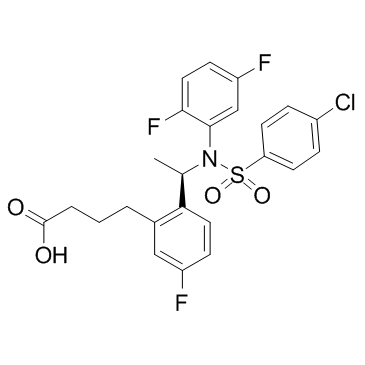| Description |
BMS 299897 is a sulfonamide γ-secretase inhibitor with an IC50 of 7 nM for Aβ production inhibition in HEK293 cells stably overexpressing amyloid precursor protein (APP).
|
| Related Catalog |
|
| Target |
IC50: 7 nM (Aβ, in HEK293 cells)[1]
|
| In Vitro |
BMS-299897 reduces the levels of each of the Aβ peptides. At 1 μM, BMS-299897 decreases these peptides to levels ranging from 20 to 50% of the vehicle control. BMS-299897 treatment reduces the portion of QD-BDNF signals moving in the retrograde direction (p=0.0198) with a concomitant increase in the portion of signals moving in the anterograde direction (p=0.0147)[2].
|
| In Vivo |
BMS-299897 shows dose- and time-dependent reductions of amyloid β-peptide (Aβ) in brain, cerebrospinal fluid (CSF), and plasma in young transgenic mice, with a correlation between brain and CSF Aβ levels. BMS-299897 reduces both brain and plasma Aβ1-40 in APP-YAC mice and increases brain concentrations of APPcarboxy-terminal fragments, consistent with γ-secretase inhibition. BMS-299897, attenuates this Aβ25-35-induced Aβ1-42 seeding and toxicity. BMS-299897 is administered at 0.1-1 nmol/mouse, concomittantly with Aβ25-35 (9 nmol) in male Swiss mice. After one week, the contents in Aβ1-42 and Aβ1-40, and the levels in lipid peroxidation are analyzed in the mouse hippocampus. Mice are submitted to spontaneous alternation, passive avoidance and object recognition to analyze their short- and long-term memory abilities. Aβ25-35 increases Aβ1-42 content (+240%) but fails to affect Aβ1-40. BMS-299897 blocks the increase in Aβ1-42 content and decreased Aβ1-40 levels significantly. The compound does not affect Aβ25-35-induced increase in hippocampal lipid peroxidation. Behaviorally, BMS-299897 blocks the Aβ25-35-induced deficits in spontaneous alternation or novel object recognition, using a 1 h intertrial time interval. The co-administration of the γ-secretase inhibitor BMS-299897, in the 0.1-1 μmol/mouse dose-range, completely blocks the Aβ25-35-induced increase in Aβ1-42 content[1].
|
| Cell Assay |
Neuronal cultures are treated at indicated DIVs for 24 hrs with 1 μM BMS-299897, 2.5 μM sGSM41 or the vehicle DMSO (final concentration: 0.1%) for most of the experiments, or for different periods of time as indicated in specific experiments. Transfections of siRNAs are performed on 100,000 neurons at DIV4 using NTER Nanoparticle transfection system following the protocol provided. The siRNAs used are: 1) siRNA against rat APP, and 2) the MISSION siRNA. Knockdown experiments are optimized by examining both mRNA and protein expression of APP. A knockdown efficiency of 80% at the mRNA level as quantitated with the 7300 Real Time PCR System and 30% at the protein level by immunoblotting is routinely achieved[2].
|
| Animal Admin |
Mice[1] Male Swiss OF 1 mice, aged 7-9 weeks and weighing 32±2 g are used. Doses of 0.1, 0.3 and 1 μmol are injected i.c.v. in 1 μL simultaneously with the Aβ25-35 peptide. Animals are used at day 7-9 after i.c.v. injections for behavioral testing or sacrifice, before biochemical measures. All experiments are conducted on separate batch of mice, except spontaneous alternation and passive avoidance, which are done in series in the same animals.
|
| References |
[1]. Meunier J, et al. The γ-secretase inhibitor 2-[(1R)-1-[(4-chlorophenyl)sulfonyl](2,5-difluorophenyl) amino]ethyl-5-fluorobenzenebutanoic acid (BMS-299897) alleviates Aβ1-42 seeding and short-term memory deficits in the Aβ25-35 mouse model of Alzheimer's d [2]. Weissmiller AM, et al. A γ-secretase inhibitor, but not a γ-secretase modulator, induced defects in BDNF axonal trafficking and signaling: evidence for a role for APP. PLoS One. 2015 Feb 24;10(2):e0118379.
|


